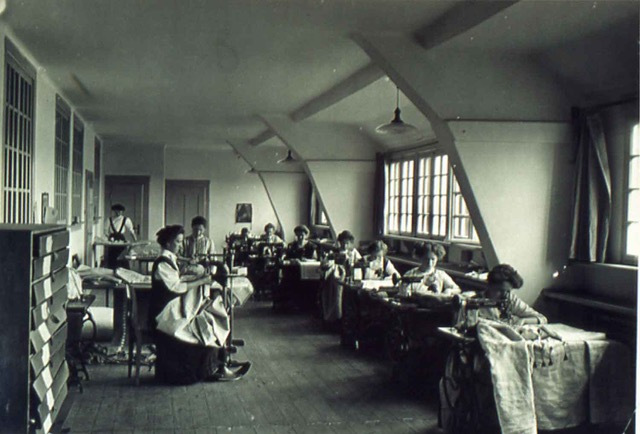The Deutsche Werkstätten Hellerau (Hellerau German Workshops) designers | Dawn of a new era
The entrepreneur Karl Schmidt saw women as an integral part and powerhouse of the arts and crafts movement as well as an economic force. No fewer than 53 female designers worked for the Deutsche Werkstätten (German Workshops), making an important and innovative contribution to design history. They designed furniture and furnishings in particular, an area previously reserved for men, but also fashion, toys, textiles and wallpaper. Among the first designers at the Deutsche Werkstätten were Gertrud Kleinhempel, Margarete Junge and Marie von Geldern-Egmond, whose designs helped the still young company achieve its breakthrough.
Content of this article

Sewing room in the Deutsche Werkstätten (German Workshops), around 1911.
Sächsisches Staatsarchiv / Hauptstaatsarchiv Dresden, 11764 Deutsche Werkstätten Hellerau Nr. F1377.
The first generation (1898 to 1918)
The reform movement’s spirit of optimism around 1900 opened up professional careers in the creative field for many female artists and designers. No fewer than 53 female designers worked for the Deutsche Werkstätten (German Workshops), making an important and innovative contribution to design history. They designed furniture and furnishings in particular, an area previously reserved for men, but also fashion, toys, textiles and wallpaper.
For the first time, the Deutsche Werkstätten (German Workshops) explicitly named the designers of their products in price guides, advertisements or at exhibitions. This gave women a public sphere that they had been excluded from until then. The entrepreneur Karl Schmidt saw women as an integral part and powerhouse of the arts and crafts movement as well as an economic force. Schmidt never made an issue of the amateurism of women, which was usually mentioned, but strove to provide both his male and female employees with a good and also artistically challenging education.
Furniture
Among the first designers at the Dresdner Werkstätten für Handwerkskunst (Dresden Workshops for Arts and Crafts) were Gertrud Kleinhempel, Margarete Junge and Marie von Geldern-Egmond. The company successfully presented their furniture designs to the public at international exhibitions as early as 1899. The designers were extremely involved in the reform movement and were later among the first women to join the Deutscher Werkbund (German Association of Craftsmen).
Kleinhempel’s furniture from the early days is above all simple and functional – it consistently met Schmidt’s demand for aesthetically sophisticated but unobtrusive designs that were to be mass-produced inexpensively for broad sections of the population.
The three female designers not only marked the Dresdner Werkstätten für Handwerkskunst’s (Dresden Workshops for Arts and Crafts) move towards a new era, but also the beginning of female careers in design. Some of their works are characteristic for the positioning of the newly founded company and the reform movement, helping it to achieve its breakthrough with their designs. As a result, they were able to resolutely advance the reorientation of German spatial art and open up new opportunities for women, especially during this time of change.
Fashion
In the search for new forms of dress from an emancipatory, aesthetic, and reformist point of view, many female artists found a niche for themselves within the arts and crafts and Lebensreform (life-reform) movements. Around 1912, Hellerau women’s dresses and fashion items were permanently exhibited in the show house at Am Grünen Zipfel 32, some of them by female artists who had previously been featured in the special catalogue from the Dresden company Renner: dresses by Anna Muthesius, Johanna Dohrn and Marie von Geldern-Egmond as well as hats by Margarete Mühlhausen and jewellery by Charlotte Krause.
